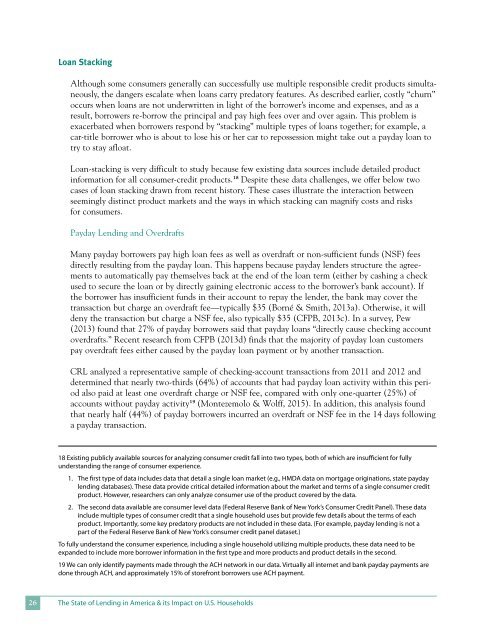You also want an ePaper? Increase the reach of your titles
YUMPU automatically turns print PDFs into web optimized ePapers that Google loves.
Loan Stacking<br />
Although some consumers generally can successfully use multiple responsible credit products simultaneously,<br />
the dangers escalate when loans carry predatory features. As described earlier, costly “churn”<br />
occurs when loans are not underwritten in light <strong>of</strong> the borrower’s income and expenses, and as a<br />
result, borrowers re-borrow the principal and pay high fees over and over again. This problem is<br />
exacerbated when borrowers respond by “stacking” multiple types <strong>of</strong> loans together; for example, a<br />
car-title borrower who is about to lose his or her car to repossession might take out a payday loan to<br />
try to stay afloat.<br />
Loan-stacking is very difficult to study because few existing data sources include detailed product<br />
information for all consumer-credit products.18 Despite these data challenges, we <strong>of</strong>fer below two<br />
cases <strong>of</strong> loan stacking drawn from recent history. <strong>The</strong>se cases illustrate the interaction between<br />
seemingly distinct product markets and the ways in which stacking can magnify costs and risks<br />
for consumers.<br />
Payday Lending and Overdrafts<br />
Many payday borrowers pay high loan fees as well as overdraft or non-sufficient funds (NSF) fees<br />
directly resulting from the payday loan. This happens because payday lenders structure the agreements<br />
to automatically pay themselves back at the end <strong>of</strong> the loan term (either by cashing a check<br />
used to secure the loan or by directly gaining electronic access to the borrower’s bank account). If<br />
the borrower has insufficient funds in their account to repay the lender, the bank may cover the<br />
transaction but charge an overdraft fee—typically $35 (Borné & Smith, 2013a). Otherwise, it will<br />
deny the transaction but charge a NSF fee, also typically $35 (CFPB, 2013c). In a survey, Pew<br />
(2013) found that 27% <strong>of</strong> payday borrowers said that payday loans “directly cause checking account<br />
overdrafts.” Recent research from CFPB (2013d) finds that the majority <strong>of</strong> payday loan customers<br />
pay overdraft fees either caused by the payday loan payment or by another transaction.<br />
CRL analyzed a representative sample <strong>of</strong> checking-account transactions from 2011 and 2012 and<br />
determined that nearly two-thirds (64%) <strong>of</strong> accounts that had payday loan activity within this period<br />
also paid at least one overdraft charge or NSF fee, compared with only one-quarter (25%) <strong>of</strong><br />
accounts without payday activity19 (Montezemolo & Wolff, 2015). In addition, this analysis found<br />
that nearly half (44%) <strong>of</strong> payday borrowers incurred an overdraft or NSF fee in the 14 days following<br />
a payday transaction.<br />
18 Existing publicly available sources for analyzing consumer credit fall into two types, both <strong>of</strong> which are insufficient for fully<br />
understanding the range <strong>of</strong> consumer experience.<br />
1. <strong>The</strong> first type <strong>of</strong> data includes data that detail a single loan market (e.g., HMDA data on mortgage originations, state payday<br />
lending databases). <strong>The</strong>se data provide critical detailed information about the market and terms <strong>of</strong> a single consumer credit<br />
product. However, researchers can only analyze consumer use <strong>of</strong> the product covered by the data.<br />
2. <strong>The</strong> second data available are consumer level data (Federal Reserve Bank <strong>of</strong> New York’s Consumer Credit Panel). <strong>The</strong>se data<br />
include multiple types <strong>of</strong> consumer credit that a single household uses but provide few details about the terms <strong>of</strong> each<br />
product. Importantly, some key predatory products are not included in these data. (For example, payday lending is not a<br />
part <strong>of</strong> the Federal Reserve Bank <strong>of</strong> New York’s consumer credit panel dataset.)<br />
To fully understand the consumer experience, including a single household utilizing multiple products, these data need to be<br />
expanded to include more borrower information in the first type and more products and product details in the second.<br />
19 We can only identify payments made through the ACH network in our data. Virtually all internet and bank payday payments are<br />
done through ACH, and approximately 15% <strong>of</strong> storefront borrowers use ACH payment.<br />
26<br />
<strong>The</strong> State <strong>of</strong> Lending in America & its Impact on U.S. Households


